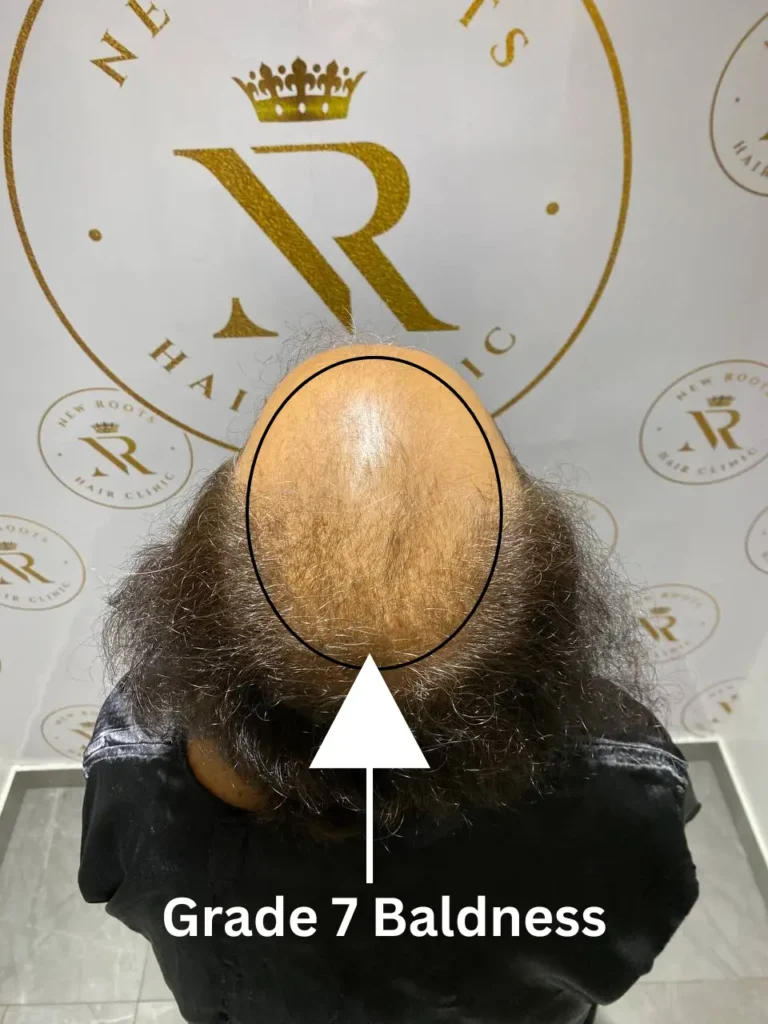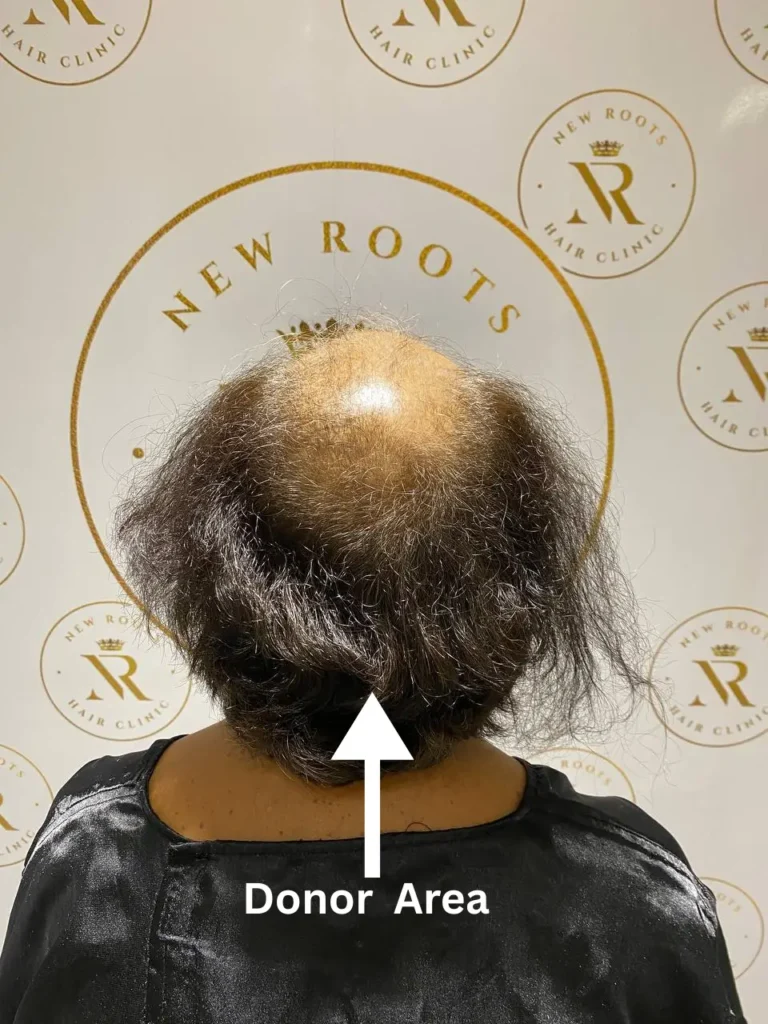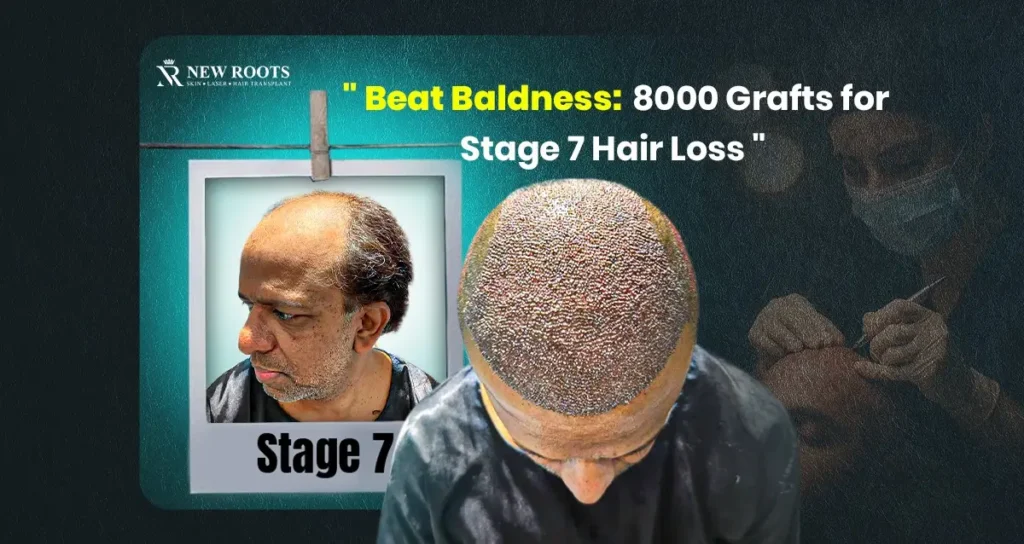Introduction
This has led many people to seek hair restoration techniques that will enable them to have fuller hair. Of all of them, the 8000-graft hair transplant is proving to be a big solution for all those who have lost a lot of hair.
This procedure is especially appropriate for Norwood stage 7 men, though far-advanced or strong MPB starts to impact the scalp intensely at this level. This article will discuss the 8000 grafts hair transplant, key questions and answers, and an overall guide for such candidates.
Table of Contents
Exploring Male Balding – Why It Occurs

Androgenetic alopecia, better known as male pattern baldness is an inherited disease in which hair shedding is either progressive or unrelenting.
The Norwood scale subdivides this type into various degrees: from level 7, the top of the head is shaved completely, and only the end of the hair grows in the ring shape at the temporal and nuchal lines.
This usually calls for massive hair restoration measures, as in the case of an 8000 grafts hair transplant.
What does an 8000-graft Hair Transplant mean?
In an 8000-graft procedure, approximately 8000 hair follicular units are harvested from a donor area of the body and then transplanted to the balding regions of the scalp.
This procedure could help someone with a hair problem regain hair density and have a natural hair texture.
The process of transplantation itself is very delicate and may take several hours to perform; it is carried out under local anesthesia.
A Good Candidate for 8000-Graft Hair Transplant: What You Absolutely Must Know?

Deciding on whether you require an 8000 grafts hair transplant depends mostly on the level of baldness. Candidates for this procedure can be selected and assessed using the Norwood scale.
Should you fall under stage 7, and you notice advances balding this could be done. A hair transplant surgeon will tell you whether you qualify for such a procedure.
Eligibility for Receiving an 8000 Grafts Hair Transplant

An 8000-graft hair transplant doesn’t work for every person. Things that affect one’s eligibility are healthy donor hair availability, hair loss severity, and overall health status.
An exhaustive evaluation by a trained specialist can establish if a large number of grafts is possible based on your personal hair characteristics and your health condition.
Common Considerations:
Scalp Thickness: For successful hair transplants, a healthy donor area full of hair follicles is very important.
Age: Young patients are typically more stable options because hair loss patterns can continue to change.
Existing Health Conditions: Eligibility can be affected by conditions that might interfere with healing.
How to Ready Yourself for an 8000 Grafts Hair Transplant
Daily Scalp Massage: Give yourself a scalp massage for 10-20 minutes every day to enhance hair follicle stimulation and improve scalp elasticity, favoring the success of your hair transplant.
Limit Sun Exposure: Try to cover your scalp from the weather a few days before you have surgery. If you’re able, please remain inside, and if you do have to step out, you can either use a hat or an umbrella for protection.
Avoid Alcohol Consumption: One week before the procedure, avoid alcohol consumption because this is by typical medical practices and helps achieve the best surgical outcomes.
Stop Blood-Thinning Medications: Stop taking any drugs that could thin your blood before surgery. Taking this measure reduces the danger of excessive bleeding that can happen during a hair transplant procedure.
Quit Smoking: Stop smoking for at least two weeks before getting a hair transplant. Smoking can prevent healing and considerably slow down the healing process.
Follow the Surgeon’s Instructions: Since surgery is so intimidating, detailed adherence to the guidelines from your surgeon is necessary to reach the best possible results and the fastest healing progress.
Hair Transplant Technology
New advancements in hair transplant technology have both increased safety and improved procedure effectiveness. With techniques like Follicular Unit Extraction (FUE) and Follicular Unit Transplantation (FUT) changing and evolving, there are fewer invasive choices as well as fast recovery times.
Advantages of Advanced Technology:
Precision: Methods designed to improve the extraction and transplantation of hair follicles are enhanced.
Minimized Scarring: Tactics that minimize the look of scars afterward.
Faster Recovery Times: It is now possible for patients to quickly return to their usual activities.
FUT and FUE are the types of surgery for hair transplantation:
Hair transplantation involves the types of commonly popular transplants known as FUT and FUE.
Follicular Unit Transplantation:-
Requires removing a linear band of hair from the site of the donor.
Offers more grafts throughout one session, but the result is a linear scar.
Follicular Unit Extraction:-
Incorporates obtaining individual hair follicles.
Findings produce minimal scarring, creating a more natural look after the operation.
Scalp Micro Pigmentation:-
SMP increases the aesthetic look of hair by giving off the illusion of greater density. During the beginning of recovery, it is especially helpful when the natural hair does not appear fully.
Best Things with Scalp Micro Pigmentation:
Instant Results: Delivers instant visual density.
Low Maintenance: It is easier to maintain than a hair transplant procedure.
Finasteride and Its Role Discussions of finasteride often surround male pattern baldness, and this medicine may help lessen hair loss.
For individuals seriously considering an 8000 grafts hair transplant, it could be a good idea to utilize Finasteride to protect current hair while boosting the final result once the transplant is done.
How Finasteride Works:-
DHT Blocker: Avoids the change of testosterone into dihydrotestosterone (DHT), a hormone that correlates with hair loss.
Anticipated Side Effects of Hair Transplant:

Bleeding:
A little bleeding may happen during or after hair transplant surgery. Managing this is usually within achievable limits and infrequently brings serious risks, yet any excessive bleeding needs to be immediately communicated to your surgeon for assessment.

Infection:
The chance of surgical sites developing infection or pus is small. Correct post-operative management, which features the right antibiotic regimen, can greatly reduce this threat, supporting a smoother recuperation experience for the individual.

Pain, Itching, and Swelling:
Donor and recipient areas might both experience discomfort that is mild, itching, or swelling. On occasion, the swelling can affect local areas, for example, eye regions, but usually responds to time or medications.
Loss of Sensation:
Several patients might temporarily lose sensation close to the incision points. This symptom typically corrects itself in about a few weeks; however, extended numbness deserves discussion with a healthcare expert.

Inflammation of Hair Follicles:
A hair follicle could be inflamed as a result of the procedure. Generally speaking, proper care will clear up this condition, known as folliculitis. Further evaluation by the surgeon is suggested if symptoms go on.
Epidermal Cyst Formation:
Due to ingrown hairs after surgery, an epidermal cyst can appear. Although this is rare, patients need to keep an eye out for any lumps or bumps and reach out for medical guidance if they do show up.
Who can undergo an 8000 grafts hair transplant?
Level 7 Baldness: An 8000 hair graft hair transplant is perfect for patients classified as Level 7 on the Norwood scale, which is associated with considerable baldness. This level calls for a major number of grafts for efficient restoration.
Graft Availability: A donor hair supply that is sufficient for an 8000 grafts hair transplant is necessary for candidates. This guarantees that we can harvest an adequate number of healthy follicles to acquire the updated fullness.
Hair Attributes: The assessment by surgeons on the donor area covers hair color, hair density, hair texture, hair thickness, and flexibility. These factors affect the success of the transplant as well as the aesthetic results.
Overall Health: Assessing the health status of the patient fully is important. The existence of any medical issues that could impact hair loss or the results of surgery should be regarded as a crucial criterion for admissibility.
Realistic Expectations: Patients need to have practical expectations concerning the outcomes of the transplant. Despite the achievement, the feeling of longing for a specific result can differ based on personal characteristics.
The Benefits Associated with Hair Transplant Surgery
Enhanced Natural Appearance: People struggling with low hair density or baldness greatly benefit from hair transplants concerning appearance. Both the FUE and FUT techniques support the arranging of grafts naturally, thereby fostering a real pattern of hair growth.
Minimal Post-Surgery Complications: Generally speaking, hair transplant treatments are safe and show few complications. Following the directives given for post-operative care can contribute to lowered risks and increased recovery satisfaction.
No Hospitalization Required: Because it’s an outpatient operation, patients can come home on the same day. This simplicity enhances a comforting experience while ensuring shortened hospital stays.
Cost-Effective Solution: A hair transplant is typically less expensive than many hair restoration methods since patients pay only once for surgical expenses, medications, and the care that follows the procedure.
Almost Invisible Scarring: Standard techniques including FUE and FUT cause few scars. After healing, the scars are nearly unnoticeable, permitting a more hidden look.
Fast Recovery Time: Generally, recovery after a hair transplant happens relatively fast, with clear improvement in just a month. FUT procedures usually require 2-3 weeks for healing, encouraging a quick transition back to life daily.
The Cost of an 8000 Grafts Hair Transplant
Cost Table: compare with other country in the world
| Location | Average Cost (Min-Max)(INR) |
| India | 150000-500000 |
| Turkey | 200000-600000 |
| UK | 700000 and above |
Understanding Baldness Levels
| Norwood Stage | Description | Number of Grafts Needed | Estimated Cost (INR) |
| Stage 1 | Little or no hair loss; stable hairline | 0 – 100 | No transplant needed |
| Stage 2 | Slight thinning at temples; normal hairline | 500 – 1,000 | 20000 – 40000 |
| Stage 3 | Receding hairline in an M-shape | 1,000 – 1,500 | 40,000 – 80,000 |
| Stage 4 | Pronounced hair loss at the front and crown | 1,500 – 2,000 | 80,000 – 1,00,000 |
| Stage 5 | Significant bald area; bridging hairs thinning | 2,000 – 3,000 | 1,00,000 – 2,00,000 |
| Stage 6 | Extensive baldness; nearly complete crown loss | 3,000 – 4,000 | 2,00,000 – 3,00,000 |
| Stage 7 | Severe baldness; only fringe of hair | 4,000+ | 3,00,000+ |
The New Roots Clinic alongside 8000 Grafts Hair Transplant
Advanced hair restoration methods are the specialty of New Roots Clinic, which includes the challenging 8000 grafts hair transplant.
The clinic seeks to achieve high-density, natural results for patients who have severe hair loss, mostly concentrated at Norwood stage 7 by using both FUT and FUE techniques.
The team’s extensive experience uses advanced technology and pioneering methods to keep graft survival high and minimize the appearance of scars.
They regard the needs of their patients highly, conducting full consultations that result in practice-oriented expectations and individualized treatment programs.
The goal of New Roots Clinic is to restore trust and promote the look of individuals battling significant hair loss, accomplished through a quality pledge.
Postnatal Care and Recovery Following Transplant
Successful results from your 8000 grafts hair transplant are highly dependent on the quality of post-operative care. The advice given to patients is to follow rigorously the surgeon’s advice for the post-operative period.
- Do your best to leave your hands off the scalp.
- Follow set hair washing routines with great attention.
- Do not show the scalp to direct sunlight until it has completely healed.
Conclusion
The 8000 grafts hair transplant is a strong option for people dealing with major hair loss at Norwood stage 7. Despite encouraging results in improving hair density from this treatment, proper evaluation of eligibility, preparations, and recovery care is crucial.
To reach satisfactory results and bolster confidence for those experiencing hair loss, it’s important to interact with experienced experts and discover the diverse elements of this surgery.
FAQs
Certainly, when executed by a qualified specialist, an 8000 grafts hair transplant is safe; however, it needs a skilled surgeon to avert any possible problems associated with overharvesting.
It usually takes patients 3 to 6 months to start seeing growth, reaching complete results by the year after surgery.
Knowing the finer details of this advanced method allows possible candidates to make conscious decisions as they take their hair restoration journey with confidence.
Overharvesting of the donor region might generate hair growth that appears uneven and may cause visible scarring. Surgeons with little experience could put graft viability in jeopardy, increasing the potential for disappointing results and surgical complications after finishing the procedure.
If you seek safety, it is important to pick a reliable clinic and a doctor, certified by the board, who has expertise in high-graft transplants. A thorough examination must investigate logical expectations, research the quality of donor hair, and describe a detailed treatment plan to reduce potential hazards.
Patients ought to follow their surgeon’s aftercare guidelines strictly after surgery. This means stopping touch to the scalp, keeping a check on sun exposure, and taking prescribed medication to inhibit infection and support graft survival for improved results.




